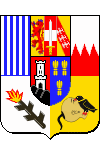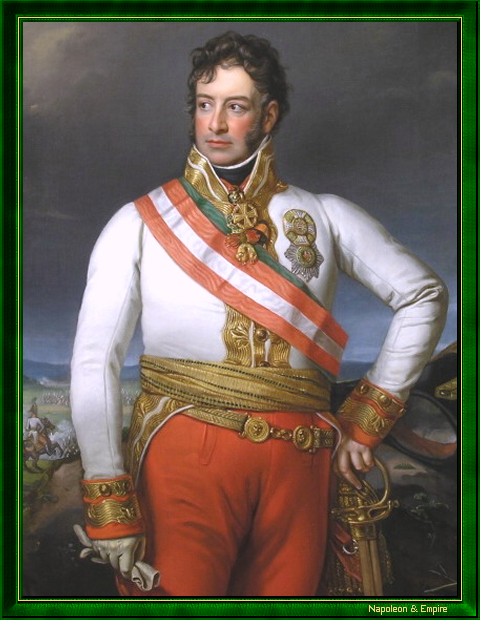Karl Philipp fürst zu Schwarzenberg
Fürst zu Schwarzenberg

Charles-Philippe zu Schwarzenberg was born on April 15 (some sources give 18 or even 19), 1771, in Vienna [Wien], into a prestigious family of the Austrian high aristocracy. He was the third son of Prince Johann of Schwarzenberg and Countess Marie Eleonore of Oettingen-Wallerstein.
In 1788, at the age of 17, he joined the Brunswick infantry regiment as a second lieutenant, after training at the Theresian Military Academy in Wiener-Neustadt. In 1789, he received his baptism of fire in a war against the Turks. His courage and aptitude for command earned him rapid promotion. Appointed captain after a feat of arms at Sabacz [Šabac], in Slavonia, he was promoted to major in 1790 and joined the cavalry, first as a dragoon, then as an uhlan in 1792.
The war that soon broke out between revolutionary France and Austria offered the young Schwarzenberg new opportunities to shine. He seized them at the battle of Quiévrain (April 29/30, 1792), then the following year at Neerwinden (March 18), Valenciennes, Oisy and Estreux-lès-Landrecies, which earned him promotion to lieutenant-colonel. In early 1794, having just been appointed colonel of a cuirassier regiment, he distinguished himself with a victorious charge that changed the course of the battle at Cateau-Cambrésis (April 26). This feat was rewarded with the Military Order of Maria Theresa, which the young Emperor Francis II presented to him in person on the battlefield. Schwarzenberg was just 23 years old, but he didn't stop there. He distinguished himself again at Würzburg on September 3, 1796, and was soon promoted to the rank of major-general (brigadier-general).
In 1799, Schwarzenberg took part in the battles of Ostrach and Stockach, and was promoted to Feldmarschall-Leutnant (lieutenant-general). After a brief career break necessitated by his wife's state of health, he returned to service in the winter campaign of 1800, commanding a division at Hohenlinden. Although the engagement ended in defeat, his personal actions saved the Austrian right wing. Archduke Charles then put him in charge of his rearguard. Charles-Philippe fulfilled this role to his leader's complete satisfaction. As a reward, at the latter's suggestion, the Emperor granted Schwarzenberg ownership of a regiment of Uhlans. This unit retained its name until 1918.
After the end of hostilities, the prince initially took on various diplomatic tasks, in particular at the court of Tsar Alexander I, before settling on his lands in Bohemia until 1805.
When the Third Coalition came into being, Schwarzenberg was given command of one of the main army corps, under General Karl Freiherr Mack von Leiberich. At the head of the right wing, he took part in the Battle of Haslach-Jungingen on October 11, 1805, against the French division of General Pierre Dupont de l'Étang. However, he had already left Ulm by the time of its surrender. After handing over his command to one of his subordinates, he escaped through the French lines on the evening of the 14th, accompanied by Archduke Ferdinand of Austria (the army's nominal general-in-chief) and several thousand cavalry. Joachim Murat pursued them in vain for five days.
Having joined Emperor Franz II and Tsar Alexander I in Moravia, Schwarzenberg took part in the battle of Austerlitz with his usual courage, although he questioned its appropriateness. Once peace was signed, the Austrian emperor rewarded his services with a promotion to the rank of commander in the Order of Maria Theresa (May 1806) and an appointment as ambassador to St. Petersburg. The Prince was tasked with securing the neutrality of the Russians, now allies of the French, in the event of renewed war between Austria and France. His efforts in this role earned him the knighthood of the Golden Fleece in 1809.
Schwarzenberg returned to Vienna only a few days before the battle of Wagram, in which he took part at the head of a cavalry corps. Although he had little influence on the course of the fighting, he did greatly facilitate the Austrian army's retreat. Two and a half months later (September 26, 1809), he was appointed cavalry general.
Once peace was restored, Klemens Wenzel von Metternich, now Chancellor, appointed Schwarzenberg ambassador to Paris. He presented his credentials to Napoleon on November 26, 1809. In this position, the prince successfully negotiated the union of the French Emperor with Archduchess Marie-Louise, daughter of the Austrian Emperor. His stay in Paris was also marked by a tragic incident. On July 1, 1810, during a ball held on the embassy premises to celebrate the imperial wedding, a fire broke out, probably claiming dozens of victims. However, the censors admitted only one, the ambassador's sister-in-law, Pauline d'Arenberg.
In 1812, at the request of Napoleon himself, who liked him, Schwarzenberg was given command of the Austrian contingent incorporated into the Grande Armée for the invasion of Russia. At the head of these 30,000 men and then of the entire VII Corps, the right (southern) wing of the force, he inflicted several minor defeats on the Russians, at Gorodetschna (July 30 and 31) and Wolkowisk [Vawkavysk] (November 15 and 16). Towards the end of the campaign, he held off the 80,000 men of Admiral Pavel Vassilievitch Tchitchagov and, after the passage of the Berezina, those of General Alexandre-Louis Andrault de Langeron. By covering Warsaw, he facilitated the retreat of the French army and gave his youthful friend Józef Antoni Poniatowski time to organize his Polish troops. Schwarzenberg then took the Austrian contingent back to Krakow in Galicia, passed on his command to a deputy and returned to his diplomatic post in Paris, perhaps to facilitate future peace talks. In April 1813, during an interview at Saint-Cloud, Emperor Napoleon I repeatedly expressed his satisfaction with his services. And these were not just empty words, since Napoleon had already advised his father-in-law, the Emperor of Austria, to appoint Schwarzenberg Field Marshal, a recommendation that took effect on October 2, 1812.
After his return to Austria in May 1813, Schwarzenberg was chosen as General-in-Chief of the main Austrian army, known as the Bohemian Army, in preference to the Archduke Charles, who was nevertheless favored by public opinion. When Austria declared war on France on August 11, 1813, the prince had around 250,000 men under his command. This did not prevent him from being defeated at Dresden on August 26 by Napoleon, at the head of half as many troops. Two months later, however, Schwarzenberg won a resounding victory at Leipzig, in a battle he had planned himself, in which he commanded the main Allied army and played a decisive role by personally leading a cavalry charge against Murat. After the victory, he entered the city on October 19 alongside Alexander I, Francis II and Frederick William III of Prussia.
Schwarzenberg was then one of those who urged the allied sovereigns to pursue their advantage without delay, and, this advice having been approved, crossed the Rhine on December 20 and 21, 1813. In January 1814, he was appointed Generalissimo of the coalition forces. His military talents alone did not justify this choice, which he owed just as much to his diplomatic skills and his flexibility as a courtier. Indeed, the position required the ability to accommodate the presence of three sovereigns close to (or, in fact, above) him, all determined to give their sanction to the slightest decision taken.
During the campaign in Northeast France, Schwarzenberg opted for cautious tactics, which he was not always able to impose on his most restless subordinate, the Prussian general Gebhard Leberecht von Blücher. After an initial success at La Rothière, the coalition suffered a series of setbacks due to these disagreements, and Napoleon was soon back in the saddle. Nevertheless, further victories at Arcis-sur-Aube and Fère-Champenoise, the decision to march on the capital at all costs, and defections and betrayals among the French military and political elite, led to the capitulation of Paris (March 31, 1814), Napoleon's abdication (April 4) and the fall of the Empire (April 14).
The victors conferred the highest honors on Schwarzenberg, and the Austrian Emperor appointed him President of the Austrian War Council (a kind of Ministry of War). On May 5, the prince left the leadership of the Allied armies to return to Bohemia, via Vienna, where he was enthusiastically welcomed.
Schwarzenberg did not take part in the Congress of Vienna, but during the Hundred Days was given command of the Upper Rhine Army (some 250,000 men), which played no part in the campaign in Belgium and Napoleon's final downfall. However, he crossed the Rhine into Alsace on June 22, 1815, and entered France, where he remained for just a few weeks before returning to his homeland. A first stroke in 1817 left him handicapped. A second, in Leipzig in 1820, led to his death on October 15 of the same year. The Austrian army honored his memory with a three-day mourning period.
Schwarzenberg is buried in Orlik, Bohemia (now in the Czech Republic), in the heart of his family's former estate.
"Karl Philipp, fürst zu Schwarzenberg".

An equestrian statue of Karl Philipp zu Schwarzenberg , work of Ernst Julius Hähnel, has honored his memory since 1867 on the square that bears his name in Vienna.